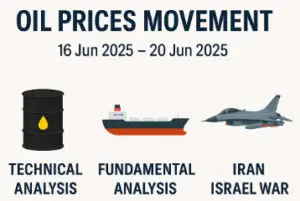📉 Forex Forecast 2025 & Major Forex Pairs Analysis Amid Iran–Israel War
As geopolitical tensions intensify, the Iran–Israel war is quickly becoming one of the most significant market-moving events of 2025. Its impact is echoing across global financial systems, especially in the Forex market, where traders are re-evaluating risk, safe-haven flows, and interest rate expectations. This article delivers a data-driven Forex forecast for 2025 and a comprehensive major Forex pairs analysis, shaped by the ripple effects of this ongoing Middle East conflict.
🧭Global Forex Forecast – Key Market Drivers – What’s Really Moving Forex in Mid-2025?
🛢 1. Oil Prices: The Inflation Wildcard
The Strait of Hormuz is once again the world’s most dangerous bottleneck. As Iran and Israel trade blows—directly and through proxies—oil markets are on edge. Nearly 20% of global crude passes through this chokepoint. Any hint of disruption sends oil soaring.
Impact on Forex:
- Currencies of oil importers (like the Eurozone, UK, and Japan) get hit hard as energy costs skyrocket.
- Oil exporters (like Canada) should benefit—but only if markets aren’t panicking.
- Rising oil means rising inflation, which throws central banks into a policy dilemma.
📈 Brent crude has jumped from $66 to over $73 per barrel in just two weeks—an 11% spike. That’s inflationary fuel, and it’s putting Forex traders on edge.
🏦 2. Central Bank Chess: More Complex Than Ever
Normally, traders look to central banks for direction. But in times of war, even the most calculated policy can get derailed.
- Federal Reserve: Sitting tight, but watching inflation. If oil keeps rising, the Fed may delay rate cuts—and that supports the USD.
- ECB: Walking a tightrope. Hiking into a fragile economy is risky, but not acting could let inflation run hot.
- BoE: The UK economy is slowing. The Bank of England is torn between helping growth and containing prices.
- BoJ: Still dovish. Japan’s central bank seems frozen, even as the yen lingers at weak levels.
- SNB: Quiet but steady. The Swiss National Bank remains neutral, which helps CHF retain its safe-haven glow.
💬 The theme? Central banks want stability—but this war may force their hand.
🧨 3. Safe-Haven Demand: USD, JPY, and CHF Take the Stage
When markets get scared, money flows into currencies seen as safe—regardless of interest rates or economic performance.
- USD: Still king. Backed by liquidity, Treasuries, and global dominance, the dollar attracts capital when tensions rise.
- JPY: Japan may not be in the spotlight politically, but its currency remains a global fallback—despite low yields.
- CHF: The Swiss franc has a quiet power. It doesn’t surge loudly but holds firm in crises.
📉 This is why riskier currencies like AUD, NZD, and even GBP are under pressure—even if their fundamentals aren’t terrible.
📉 4. Investor Sentiment & Market Psychology
In volatile times, perception often outweighs reality. Traders aren’t just reacting to economic data—they’re pricing in “what if” scenarios:
- What if the war spills into Saudi Arabia or the UAE?
- What if oil goes above $85?
- What if shipping lanes are blocked or sabotaged?
Even rumors or headlines from unnamed sources can shift entire pairs. Algorithms respond in milliseconds, and humans follow in emotional waves. In this environment, even currencies with strong fundamentals can be punished by fear.
💡 Tip for traders: Watch the news as closely as the charts.
📊 Forex Forecast 2025: Latest Major Forex Rates (June 17, 2025)
| Currency Pair | Rate | Daily Change |
|---|---|---|
| EUR/USD | 1.1568 | -0.12% |
| GBP/USD | 1.3527 | -0.21% |
| USD/JPY | 144.50 | +0.05% |
| USD/CAD | 1.3374 | +0.11% |
| AUD/USD | 0.6652 | -0.17% |
| NZD/USD | 0.6079 | -0.15% |
| USD/CHF | 0.8957 | +0.03% |
🔍 Major Forex Pairs Analysis – Technical & Fundamental Breakdown
🇪🇺 EUR/USD – Under Pressure from Energy Inflation
-
Bias: Bearish
-
Support: 1.1500
-
Resistance: 1.1650
-
Outlook: Oil-driven inflation weakens the euro. A break below 1.1500 opens downside to 1.1420 unless ECB tightens unexpectedly.
🇬🇧 GBP/USD – Brexit Linger + Global Fear
-
Bias: Neutral to Bearish
-
Support: 1.3440
-
Resistance: 1.3650
-
Outlook: UK economic fragility and global risk aversion cap gains. Watch for triangle breakdown targeting 1.3350.
🇺🇸🇯🇵 USD/JPY – Rangebound But Poised
-
Bias: Sideways
-
Support: 143.30
-
Resistance: 145.80
-
Outlook: A breakout could push to 147.00 as the dollar strengthens, unless JPY benefits from safe-haven flow.
🇨🇦 USD/CAD – Oil Can’t Do It Alone
-
Bias: Neutral/Bullish
-
Support: 1.3310
-
Resistance: 1.3440
-
Outlook: Despite high oil, CAD struggles. Only a strong technical breakout clears the path to 1.3550.
🇦🇺 AUD/USD – Commodity Risk, China Drag
-
Bias: Bearish
-
Support: 0.6600
-
Resistance: 0.6700
-
Outlook: Risk-off sentiment and weak Chinese data keep AUD pinned down. A break below 0.6600 targets 0.6530.
🇳🇿 NZD/USD – Weak Kiwi in Risk-Averse Market
-
Bias: Weak/Neutral
-
Support: 0.6000
-
Resistance: 0.6150
-
Outlook: Trapped below EMAs, Kiwi lacks momentum. A break below 0.6000 would signal deeper downside.
🇨🇭 USD/CHF – Quiet Climb into Resistance
-
Bias: Slightly Bullish
-
Support: 0.8880
-
Resistance: 0.9050
-
Outlook: CHF holding strong due to Swiss neutrality and safe-haven demand. Watch for resistance breakout.
🧠 Key Themes Shaping Forex Forecast 2025
-
Oil Shock: Brent at $73+/bbl fuels inflation.
-
Central Bank Divergence: ECB cautious, Fed data-driven, BoJ dovish.
-
Safe-Haven Flows: USD, JPY, and CHF in demand.
-
Market Sentiment: Traders price in geopolitical fear as much as economic fundamentals.
📌 Final Takeaway: Trading the War-Driven Forex Landscape
The Iran–Israel war is reshaping how currencies move. While major Forex pairs like EUR/USD and USD/JPY stick to technical ranges, their next big move hinges on global peace—or its absence.
Pro Trader Tips:
-
Stay alert to headlines—wars change markets faster than data.
-
Pair technical signals with macro triggers.
-
Respect volatility and keep tight risk parameters.



